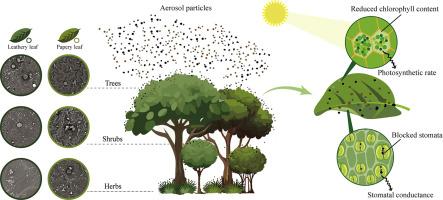Comparing the compositions and influence of aerosol particles retained on trees, shrubs, and herbs
IF 6.3
2区 环境科学与生态学
Q1 ENVIRONMENTAL SCIENCES
引用次数: 0
Abstract
Aerosol particle pollution has become an increasing serious environmental problem, and urban vegetation plays a long-lasting and positive role in mitigating it. This study compared the particle capture abilities of trees, shrubs, and herbs, and examined the compositions and influence of aerosol particles accumulated on leaf functional traits. Retained particles primarily contained Ca2+, K+, SO42−, NO3− and NH4+, indicating their anthropogenic origins. The leathery-leaved tree Osmanthus fragrans and the papery-leaved herb Alternanthera sessilis demonstrated the higher competence in particle accumulation than other plants, and leaf morphologic structures (e.g., leaf grooves, trichomes, waxy layers, and stomata characteristics) were closely associated with particle capture by plant species. Particle retention negatively impacted stomata, impeding photosynthesis, and reducing transpiration. In response to particle accumulation, plants tended to decrease specific leaf area and adjust stomatal conductance. Both growth form and leaf texture significantly influenced the particle capture abilities of different plant species. The substantial contribution of plants, particularly herbs in the lower vegetation strata, to particle removal should not be overlooked. Vegetation with a tree-shrub-herb configuration excels at particle capture, offering potential advantages in mitigating particle pollution and enhancing ecological benefits.

比较滞留在树木、灌木和草本植物上的气溶胶颗粒的组成和影响
气溶胶颗粒污染已成为日益严重的环境问题,城市植被在缓解气溶胶颗粒污染方面发挥着持久而积极的作用。本研究比较了乔木、灌木和草本植物的颗粒捕获能力,研究了气溶胶颗粒的组成及其对叶片功能性状的影响。残留颗粒主要含有Ca2+、K+、SO42−、NO3−和NH4+,表明其人为来源。革叶树桂花和纸叶草互花具有较强的颗粒积累能力,叶片形态结构(如叶沟、毛状体、蜡层和气孔特征)与植物的颗粒捕获密切相关。颗粒滞留对气孔产生不利影响,阻碍光合作用,减少蒸腾作用。在颗粒积累过程中,植物倾向于降低比叶面积和调节气孔导度。不同植物的生长形态和叶片质地对颗粒捕获能力有显著影响。植物,特别是下层植被层的草本植物,对颗粒去除的巨大贡献不应被忽视。乔灌草植被具有较强的颗粒捕获能力,在减轻颗粒污染和提高生态效益方面具有潜在优势。
本文章由计算机程序翻译,如有差异,请以英文原文为准。
求助全文
约1分钟内获得全文
求助全文
来源期刊

Journal of Environmental Sciences-china
环境科学-环境科学
CiteScore
13.70
自引率
0.00%
发文量
6354
审稿时长
2.6 months
期刊介绍:
The Journal of Environmental Sciences is an international journal started in 1989. The journal is devoted to publish original, peer-reviewed research papers on main aspects of environmental sciences, such as environmental chemistry, environmental biology, ecology, geosciences and environmental physics. Appropriate subjects include basic and applied research on atmospheric, terrestrial and aquatic environments, pollution control and abatement technology, conservation of natural resources, environmental health and toxicology. Announcements of international environmental science meetings and other recent information are also included.
 求助内容:
求助内容: 应助结果提醒方式:
应助结果提醒方式:


